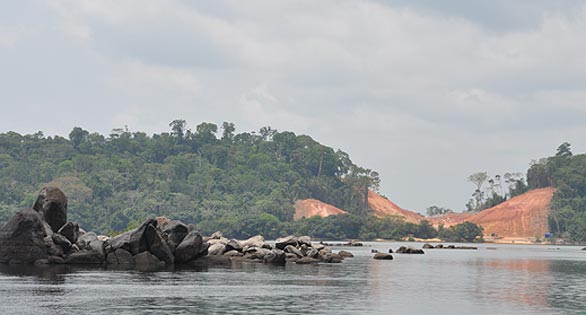
Damming and diversion of the Río Xingu will displace tens of thousands of indigenous people in the heart of the Amazon basin and threaten native stocks of fishes caught for food and export to aquarists.
Looking for species threatened by Brazil’s massive Belo Monte Project
by Dr. Mark Sabaj Pérez—Special Report
Excerpt from AMAZONAS, January/February 2013
With the specter of an ecosystem-killing hydroelectric dam project moving ahead in Brazil, the eyes of many concerned observers, especially those interested in the fate of native fish species, are on the Lower Xingu River.
For two weeks, from October 3–17, I joined Brazilian colleagues on a fishing expedition to the Lower Xingu near Altamira, Brazil. (I am Collection Manager of Fishes at the Academy of Natural Sciences in Philadelphia.) During this time of year, the Xingu is at its lowest seasonal point, and many species of fish become crowded together, making them easier to find and catch.
The collecting group included Dr. Leandro Sousa, a professor at the Universidade Federal do Pará, Altamira campus, who is part of a team of Brazilian scientists conducting aquatic surveys of the Lower Xingu in the stretches that will be affected by the construction of the Belo Monte Dam. Dr. Mariangeles Arce, an expert on the molecular evolution of thorny catfishes (Doradidae), is also on the team; she recently completed her doctoral degree at the Pontifícia Universidade Católica do Río Grande do Sul in Porto Alegre, Brazil, and is now a Research Associate at the Academy of Natural Sciences.
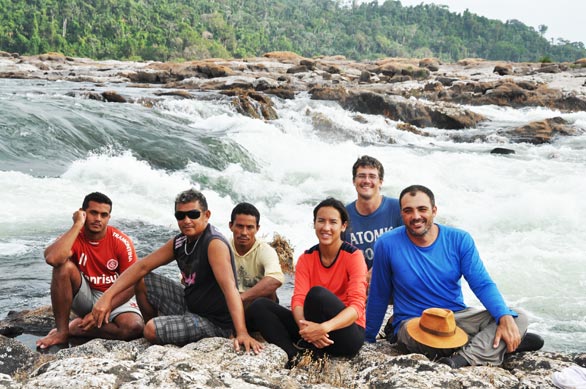
Expedition team (left to right): Edson, Zezinho, Dani, Dr. Mariangeles Arce, Dr. Mark Sabaj Pérez, Dr. Leandro Sousa.
The expedition consisted of four separate trips. The first was a day trip by car to a tributary of the Río Penatecaua, a small, isolated tributary of the Amazon about 50 miles (80 km) west-southwest of Altamira on Route 230. The second was another day trip, this time by boat (voadeira in Portuguese), to a shoal made up of sand, gravel, and platelike conglomerates and a rocky outcrop in the Río Xingu about 9 miles (15 km) upstream from Altamira.
The third and fourth trips were also by voadeira. On the third we ventured upstream on the Xingu to its major left-bank tributary, the Río Iriri, and then proceeded about 9 miles (15 km) up the Iriri to a large waterfall, Cachoeira Grande. The fourth trip took us downstream of Altamira, into the large, bell-shaped curve in the Lower Xingu called Volta Grande (Big Bend) and as far as Cachoeira do Jericoá, about 34 miles (55 km) east-southeast of Altamira, where the Xingu suddenly drops through a series of powerful waterfalls. We also made a stop at the Río Bacajá, a small right-bank tributary of the Xingu. Two of the most skilled and respected pleco fishermen in Altamira, Dani and Edson, as well as our skipper, Zezinho, and our cook, Rai, accompanied us on the last two trips.
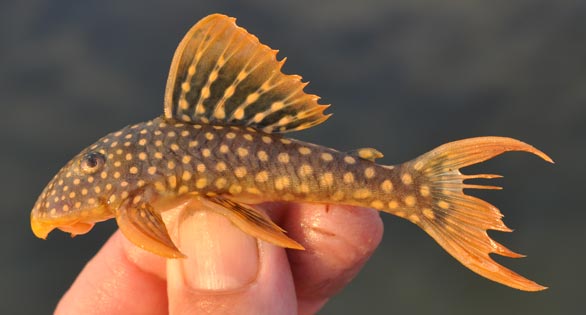
Scobinancistrus aureatus, described by Burgess in 1994 from the Lower Xingu. Known as the Sunshine Pleco or Goldie Pleco, it is one of the species threatened with extinction by the Belo Monte project.
The expedition netted and preserved about 2,500 specimens, including tissue samples of about 350 individuals for molecular analysis, from a total of 11 sites. The pleco hunting was extremely good, with about 25 species recorded, most caught by Dani and Edson. Highlights included two species of Scobinancistrus (S. aureatus and S. paríolispos), three species of Baryancistrus (B. chrysolomus, B. niveatus, and B. xanthellus), the rare Leporacanthicus heterodon, two species of Hypancistrus, H. zebra and one undescribed (L174), two or three Spectracanthicus, including one undescribed (L020), and a beautiful specimen of an undescribed Pseudacanthicus (L025).
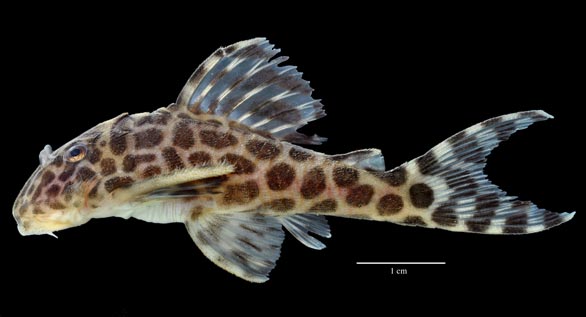
New species of Hypancistrus (L174) to be described by Leandro Sousa, found along rocky ledges over 52 feet (16 m) deep. Deep water habitat may become scarce for such species after water is diverted from Volta Grande.
The specimens were divided between and vouchered at the Academy of Natural Sciences of Philadelphia and Instituto Nacional de Pesquisas da Amazônia in Manaus, capital of the Brazilian state of Amazonas. The purposes of the expedition were 1) to collect additional specimens and tissue samples of undescribed species under study by Mark, Leandro, Mariangeles, and colleagues; 2) to take photographs of live fishes, their habitats, and the conditions of the river; 3) to test logistics and collecting gear for future expeditions to the Lower Xingu; and 4) to contribute to baseline estimates of fish diversity in varíous stretches of the Lower Xingu príor to its modification by the Belo Monte Dam complex. The expedition was funded in part by a generous donation from Julian Dignall and PlanetCatfish.
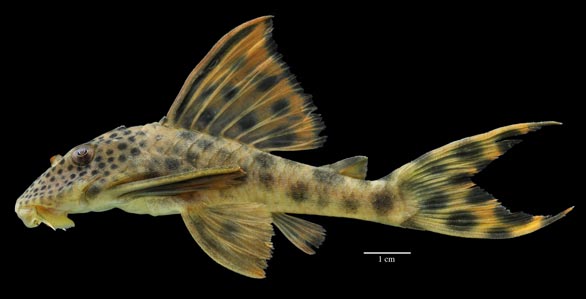
Xingu version of Peckoltia sabaji, a species described by Armbruster in 2003 based on Essequibo specimens.
Dam construction in progress
Construction on the Belo Monte Dam complex appears to be progressing swiftly, despite legal challenges and the protests of indigenous tribes whose lands and livelihoods are threatened.
We did not visit the construction site, but caught a glimpse of the temporary low dam of rocks, sand, and mud being built across the entire channel in the upstream portion of Volta Grande (a site known as Pimental). Here the river channel is divided into a number of streams by islands and small shoals. The low dam has been creeping across the Xingu all year, and now only the largest section of the river, along the western bank, remains unimpeded. Leandro said that early in the construction, the Xingu overpowered the low dam in what was locally regarded as a big victory for nature. But since then, the dam builders have been the victors. From time to time, groups of indigenous peoples gather at the construction site to protest the dam. Their protests are largely peaceful and largely ignored.
Toward the end of our expedition, the rainy season began and the Xingu started to rise. Presumably, construction of the dam will be suspended, given the increased flow of the river. Once the river subsides again next year, the low dam (assuming it remains intact) will not take long to complete. Eventually, a more permanent dam will be built at Pimental, impounding the Lower Xingu to form the Calha do Xingu Reservoir, which will extend upstream to about half the distance between Altamira and the mouth of the Río Iriri. From the reservoir, the Xingu’s water will be diverted through two large canals being dug toward Belo Monte near the downstream limit of Volta Grande.
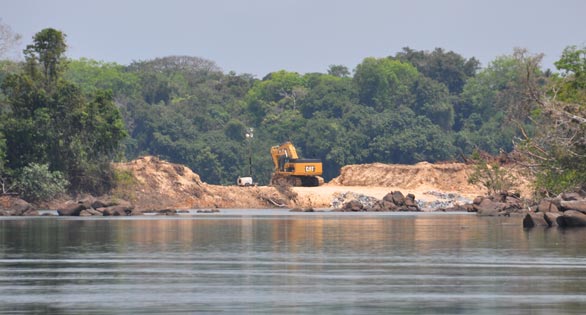
Despite protests from indigenous peoples and environmental groups worldwide, the Belo Monte construction is forging ahead.
Some have estimated that more earth is being displaced for these diversion canals than was removed during the construction of the Panama Canal. The portion of Volta Grande that is not inundated by the reservoir will be effectively “short-circuited” by the canals. No one knows exactly how much water will be diverted through the canals to generate electricity via Belo Monte. Therefore, no one knows exactly how much water will remain to fill the complex labyrinth of narrow channels that make up the downstream portion of Volta Grande.
Experts estimate that Volta Grande will retain only one-third of the water it normally contains at flood level. In the low-water season, many of the shallow channels could become isolated and go completely dry, resulting in heavy losses for resident fishes and other aquatic organisms. One thing is for sure: much of the Belo Monte Dam complex will be completed soon…perhaps by the end of the next dry season.
Latest word from Dr. Mark Sabaj Perez:
In November 2012, the US National Science Foundation approved funding for an inventory of aquatic organisms in the Lower Xingu Rapids.
The so-called “Xingu Project” will be led by Drs. Mark Sabaj Pérez and John Lundberg at the Academy of Natural Sciences, Dr. Lúcia Rapp Py-Daniel, Curator of Fishes at the Instituto Nacional de Pesquisas da Amazônia in Manaus, and Leandro Sousa, professor at the Universidade Federal do Pará, Altamira campus.
Three more expeditions are planned for the Lower Xingu in 2013 and 2014 to study and document the diversity of aquatic life and habitats in the rapids.
More Belo Monte coverage in AMAZONAS






Trackbacks/Pingbacks